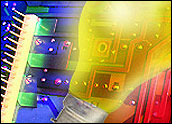
Some of us have never heard of 3D printing. The fact is, this type of “printing” will revolutionize manufacturing and change where, how fast, and at what cost products will be produced.
Let’s imagine for a moment a manufacturer’s utopia — being able to produce a tailor-made product at an unbelievably low cost and being able to make these products in customers’ back yards, not overseas.
Sound incredible and too utopian? Well, my guess is that within the next 10 years, we’ll be well into 3D printing, which will make all of this possible.
What Is 3D Printing?
3D printing is quite a bit unlike conventional printing in that a so-called printer makes an actual three-dimensional (not virtual) object. 3D printing is also called “additive manufacturing” because an object is made by continually adding layer after layer of raw material based upon a design that comes from a digital file.
Subtractive manufacturing is traditional manufacturing, wherein a piece of metal might be reduced and milled by a lathe. This piece of metal would then eventually become part of a product, once all of the product’s parts and pieces are assembled.
With 3D printing, a product can be made from scratch based upon a computer aided design, CAD, that is downloaded to the printer. The printer then does the rest, printing out layer after layer of the product until the resulting end product is created.
The layers so printed, which are based upon the CAD drawing, eventually aggregate until a finished product is developed. This product can be a golf club, a hammer, a screwdriver, or even a hearing aide. It also can be manufactured to meet the specific needs of the purchaser.
Implications of 3D Printing
With such technology, the importance of economies of scale is greatly diminished. Economies of scale represent the traditional economic theory that the greater the number of identical units of a product that are produced, the lower the per-unit cost will be.
Economies of scale will probably always play some sort of a role in manufacturing. But the fact is, however, that a 3D printer can undermine that role by being able to print (create) a product based upon a technician’s mouse click. The cost of the labor for the product is therefore quite negligible. In fact, since a printer will be able to create distinct parts of a product and fuse them all together, the total cost of a single product could actually become less than that of a traditionally manufactured product. This is why economies of scale will probably become irrelevant.
New Business Model Needed for Future 3D Manufacturing
Manufacturing executives will have to re-examine their business models in the future because their primary production costs will consist of purchasing the 3D printer and buying the materials. The manufacturing venue can be a simple building with surprisingly small manufacturing space and computer rooms wherein technicians and engineers are “creating” products that are then electronically transferred to the 3D printers. The printers then do the “manual labor,” following the instructions of the computers and filling their orders. Mechanization at its best!
In this business environment of the future, executives must focus on engineering, computer technology, product design, marketing and research and development. They must also focus on hiring employees who are highly skilled in engineering and the sciences, especially computer science.
Just-in-Time (JIT) Business Environment
Most of us are quite familiar with JIT. Wikipedia describes it like so: “Just in time (JIT) is a production strategy that strives to improve a business return on investment by reducing in-process inventory and associated carrying costs. Just-in-time production method is also called the ‘Toyota Production System.'”
The way JIT works is that if a business has a state-of-the-art computer system and programs, it can greatly reduce the amount of product it produces and the amount that it carries in inventory. The business will produce product mostly as needed and keep as small amount as possible on the shelf.
With 3D printing, a company can push JIT strategies to the limit. Assuming that it has the proper technology, a company can keep virtually no product in inventory and simply manufacture on demand. This would also include manufacturing one-of-a-kind products.
With state-of-the-art 3D printing, the cost of manufacturing a unique product will be greatly reduced. In fact, I can see the day when a customer could simply e-mail the CAD specs to a producer and the producer merely has to download these specs to a sophisticated 3D printer and the printer will do the rest. The specs can be proprietary, meaning that they have to be returned to the customer once they are used and may not be used to fulfill a competitor’s order.
The Sky Is Not Falling
When I have discussed 3D printing with associates, some of them have said that computers will put more and more people out of work. My response is that since the cost of labor for the fruits of production will be so low, much of the manufacturing process will be transferred to the U.S.
My other response is that there will be plenty of jobs created by 3D printers. Those jobs will mostly be tech jobs such as computer design, programming and engineering. Additionally, jobs will be created in marketing and sales.
From my view, the future looks bright for the United States. When Gutenberg created the first printing press around 1439, I have no doubt that many people thought that it would have a negative effect on society. It turned out that they were wrong.
Good luck!









































Social Media
See all Social Media